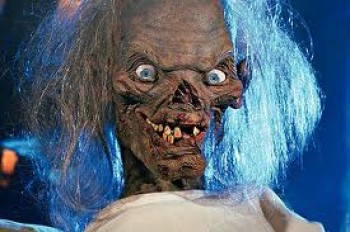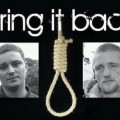Horror Anthologies: Like Now 72 With Tits and Razorblades
Programs like Tales From The Crypt condense horror films into short vignettes for TV, and they are the first horror exposure for most true fans of the genre...

When it comes to the horror genre, the biggest challenge most film-makers face, is sustaining interest once they’ve used up all their big shocks. How do you keep the audience on the edge of their seats once your plucky heroine has noticed that her friends are disappearing one by one? Can you still be frightening when the disbelieving parent has finally stopped trying to rationalise their child’s ability to ignore the laws of physics and human biology? Once the exposition sets in, suspense is thrown out of the window like one of those ubiquitous cats used for a cheap scare. Even the best horror films are lucky if they can muster more than three or four heart-stopping moments. Beyond that, the screenwriter is usually left trying to concoct a story that will sustain a viewer’s interest after they’ve chucked their popcorn all over the carpet.
Many horror fans first discover their love for a good spine-tingler, sitting around a campfire, eating carcinogenic marshmallows and listening to ghost stories. Free from the conventions of a three-act structure, or the need for complex layers of subtext, these stories have a simple purity to them. With one simple goal in mind, they tend to follow the same basic template – set-up, shock, twist. Even horror authors like Stephen King and Clive Barker appreciate the power of the short story, despite the fact that most of their books could give Geoff Capes a nasty hernia. Over the years they’ve both turned out a considerable number of grisly little anecdotes; twisted tales that cut right to the bone.
When it comes to adaptations, however, directors can either pad out the story to feature length, or make a short film that would struggle to find a distribution partner. Thankfully, there’s another option – the anthology, which takes a handful of vignettes and binds them with a wrap-around scene-setter. As well as helping a film make it to ninety minutes without throwing in an hour of mindless chatter, the different stories often allow directors to try their hand at a variety of tones. It’s even better for audiences, who get the celluloid equivalent of Heston Blumenthal’s Fat Duck taster menu, but without the risk of a nonovirus outbreak. Don’t like this story? No worries, there’ll be another one along in a couple of minutes. If nothing else, it at least increases your chances of getting some entertainment out of your trip to the cinema - all meat, no gristle.
The portmanteau adaptations produced by Amicus tended to downplay the gory details, focusing instead on the bitterly ironic stings in each tale
Most people’s fondness for this pithy sub-genre is rooted in the prolific output of Amicus studios. Ostensibly a more contemporary alternative to the capes and counts anachronisms of Hammer, Amicus offered up a slew of successful anthology films during the late 60s and early 70s. The most effective, Tales From the Crypt and The Vault of Horror, lifted their grisly anecdotes from the legendary EC comics. These luridly illustrated publications were themselves structured around an anthology model, with four eclectic stories per issue. For several years in the early ‘50s, American kids displayed a voracious appetite for the comics’ menagerie of pun-loving hosts, who served up a mouthwatering selection of miscreants and monsters, all with tongue poking grotesquely through rotted cheek. Focusing on humanity’s most gruesome foibles, the stories
All had their own internal morality – even though women tended to be portrayed as duplicitous whores or hopeless victims, often both at the same time.
The portmanteau adaptations produced by Amicus tended to downplay the gory details, focusing instead on the bitterly ironic stings in each tale. They also called upon an impressive range of well-known thespians, and Joan Collins, to create the British equivalent of Irwin Allen’s own all-star casts that were packing them in across the pond. OK, so we didn’t get Steve McQueen facing off against Paul Newman; instead we had to make do with Tom Baker and Patrick Magee. Beyond the stories lifted from EC’s regrettably short glory years, Amicus also looked to writers such as Robert Bloch (author of Psycho) and R. Chetwynd-Hayes for their story selections. Sadly, audience favour quickly waned, and by the time The Monster Club rolled around in 1980, with its animated strippers taking off more than just their clothes, viewers had moved on to more grown-up horror. It probably didn’t help that Vincent Price’s wizened countenance was more frightening than anything the second-rate special FX team could conjure up.
During the 1980s, it was Stephen King’s alarmingly prolific output that was responsible for a short-lived resurgence of interest in anthologies. With film adaptations of his novels been produced quicker than he could write them, canny producers went digging through his back catalogue to find anything they could use to keep the ravenous fans at bay. Thankfully, King had published two considerable collections of short stories, many of which still stand as some of his most interesting work. As the author gradually left horror behind in favour of more redemptive narratives for his long-form work, these twenty-pagers allowed him to prevent all that mainstream success from attacking his atrophying terror muscle.
In the space of five years, three separate anthology films were made from his short stories – Creepshow and its belated sequel, and the PG-rated Cat’s Eye. King was heavily involved in the first Creepshow, even starring as ill-fated farmhand Jordy Verrill, and scripted Cat’s Eye. However, by the time Creepshow 2 went into production in 1986, he was content to open up his back catalogue and let returning scripter George Romero take his pick.
Although these three films vary wildly in tone and execution, they all displayed a previously untapped penchant for dark humour, for both King and Romero. Having built his reputation firmly in the subgenre, the king of the zombies found himself depicting a different kind of undead – a mouldering corpse climbing from his grave, hungry for birthday cake rather than fresh brains. Since the Creepshow concept was also heavily indebted to the EC comics of King’s youth, the colour scheme was almost as over-the-top as the performances. The sequel, directed by Michael Gornick, retained the cartoonish interludes, but aimed for a more conventional horror vibe, with the standout segment being The Raft. Based on one of King’s most brutally simple concepts, this taut sequence sees four college students finding themselves trapped on a floating platform in the middle of a lake, before being devoured by a sentient oil-slick. It’s enough to give Tony Hayward nightmares.
Having built his reputation firmly in the subgenre, the king of the zombies found himself depicting a different kind of undead – a mouldering corpse climbing from his grave, hungry for birthday cake rather than fresh brains
Cat’s Eye, on the other hand, focused more on suspense than horror; in part due to the family-friendly rating demanded by producer Dino De Laurentiis. The film may have been devoid of blood, but the first two segments are still compelling almost thirty years later, thanks to committed performances from James Woods and Robert Hayes as the luckless protagonists in Quitters Inc and The Ledge. The less said about the jester troll that dwells inside Drew Barrymore’s skirting board, the better.
In the late eighties, the horror anthology evolved again, this time finding itself a new home in episodic television. Shorter running times eliminated the need to cram three stories into one presentation. Instead, viewers could tune in on a weekly basis to shows like Tales From The Darkside, Friday The 13th: The Series and Freddy’s Nightmares to discover all-new stories of death and (off-screen) dismemberment. The quality and production values varied wildly, with Darkside in particular, suffering from an incredibly low budget – usually limited to two rooms and a handful of speaking parts. Like the old saying goes, necessity is the mother of invention, so there are occasional gems to be found amongst the rubble. In some cases, the shoestring budgets and punishing schedules actually worked to the shows’ advantage, enticing notable names such as Jodie Foster, David Cronenberg, Tobe Hooper and Tom Savini into the director’s chair for a guest slot.
Inspired by the relative success of these syndicated shows, Hollywood heavy hitters Robert Zemeckis, Joel Silver, David Giler, Walter Hill and Richard Donner decided to produce their own small-screen horror anthology based, once again, on those classic EC comics. The difference was that they pitched their concept to cable channel HBO instead. Free from the stranglehold of network standards, theirs was a decidedly adult affair that reveled in its unrestrained use of gore, nudity and foul language. Adding to the show’s instant break-out success was Kevin Yagher’s fantastic Crypt Keeper puppet, voiced by John Kassir. This pun-loving ghoul combined bodily decay and pitiful gags two decades before Bruce Forsyth parlayed the same shtick into a career resurgence on Strictly. Between 1989 and 1996, seven seasons were produced, with the last one made entirely in the UK and boasting a veritable who’s-who of British stars on the cusp of superstardom. In some ways, it seemed that the anthology subgenre had woken up to find itself right back at the beginning.
But, as any good horror fan knows, nothing monstrous ever really dies. It just lies around until someone thinks it might be a good idea to dig it up in a thunderstorm. And so there were numerous unsuccessful attempts to resurrect the format throughout the nineties. Tales From The Darkside had its own stab at the big screen, and included a wraparound story featuring Debbie Harry preparing to cook and eat her paperboy. The three stories he tells her to distract her from igniting the pilot light constitute the rest of the film. A couple of years later John Carpenter and Tobe Hooper teamed up to give us Body Bags, but aside from a compelling opening sequence set in a petrol station, it was largely forgettable. The format even got its own ‘blaxploitation’ entry, made by Spike Lee’s production company 40 Acres & a Mule. Despite its distinctly urban setting, the old EC-values of revenge from beyond the grave were all present and correct.
The last great horror anthology was the long-delayed Trick ‘R’ Treat, a genuinely effective and wonderfully creepy entry by Michael Dougherty, the writer of X2 and Superman Returns. Rather than a wraparound story, Dougherty connected his vicious vignettes with the ominous spirit of a little boy called Sam, wearing orange pajamas and a burlap sack over his head. The film sat on a shelf for two years, before being released straight to DVD, but the fans’ enthusiastic reaction convinced film-makers that there was still an audience out there for a collection of well told tales.
Next January sees the long-awaited release of V/H/S, a new collection of short films from some of Hollywood’s most promising horror names. Given the popularity of films like Paranormal Activity, REC and The Last Exorcism, it’s hardly surprising that this latest anthology uses found footage to conjure up its low-res scares. Touching upon such well-worn tropes as the slasher, demonic possession and torture porn, it’s something of a ‘horror’s greatest hits’. Like Now 72, but with more tits and razorblades. And I, for one, can’t wait.
If you liked this, check these out
Monstrous Mayhem: The Top Five Horror Movies
James Herbert: The Master Of British Horror Interviewed
Click here for more stories about TV & Film
Click here to follow Sabotage Times on Twitter
Click here to follow Sabotage Times on Facebook
If you like it, Pass it on
 COMMENTS
COMMENTS
Great piece... explorations in horror are always interesting. It's a transgressive genre that has enjoyed a long life that isn't dictated to by fashion or star power... horror film fans as I have observed are a discerning bunch at times or a OTT forgiving bunch accepting anything that labels itself horror for the sake of a new film. I got to see VHS at Frightfest. It has some great stories but the title is a misnomer ... these are very modern horror films shot on digital, but played back on VHS - WHY? I've no idea ... plus when the wrap around story concludes, satisfactorily I might add, they tack on an extra tale - WHY? I've no idea.
how can anyone write about tv and not know how to spell programme?


 RELATED
RELATED










 SABOTAGE
SABOTAGE





